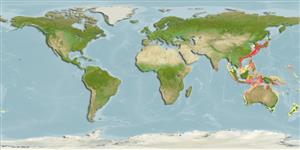Environment: milieu / climate zone / depth range / distribution range
Ecologia
marinhas demersal; intervalo de profundidade 80 - 230 m (Ref. 27966). Temperate
Indo-West Pacific: southern Japan and East China Sea. Specimens recorded from Indonesia, the Arafura Sea (Ref. 9819) and northwestern Australia (Ref. 5978) are probably new species (Ref. 13666).
Tamanho / Peso / Idade
Maturity: Lm ? range ? - ? cm
Max length : 30.0 cm SL macho/indeterminado; (Ref. 559)
Espinhos anais: 0; Raios anais : 13 - 14. Head depressed. Body without large scute-like spines. Infraorbital bones forming a strong ridge, confluent with uppermost preopercular spine and having 4-6 spines. Ratio of pectoral-fin length to caudal fin length 0.88 to 1.05 (Ref. 40506).
Found in the continental shelf (Ref. 7300). Inhabit sand or sandy mud bottoms (Ref. 11230). Neither anterolateral glandular groove nor venom gland is present (Ref. 57406).
Ciclo de vida ou comportamento de acasalamento
Maturities | Reprodução | Spawnings | Egg(s) | Fecundities | Larvas
Imamura, H. and L.W. Knapp, 1998. Review of the genus Bembras Cuvier, 1929 (Scorpaeniformes: Bembridae) with description of three new species collected from Australia and Indonesia. Ichthyol. Res. 45(2):165-178. (Ref. 27966)
Status na Lista Vermelha da UICN (Ref. 130435)
Ameaça para os humanos
Harmless
Uso pelos humanos
Ferramentas
Relatórios especiais
Baixar XML
Fontes da internet
Estimates based on models
Preferred temperature (Ref.
123201): 11.1 - 26.4, mean 19.7 °C (based on 185 cells).
Índice de diversidade filogenética (Ref.
82804): PD
50 = 0.5332 [Uniqueness, from 0.5 = low to 2.0 = high].
Bayesian length-weight: a=0.00389 (0.00180 - 0.00842), b=3.12 (2.94 - 3.30), in cm total length, based on all LWR estimates for this body shape (Ref.
93245).
Nível Trófico (Ref.
69278): 3.8 ±0.4 se; based on size and trophs of closest relatives
Fishing Vulnerability (Ref.
59153): Low to moderate vulnerability (27 of 100).
